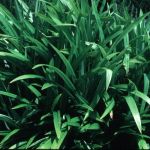| Common Name: |
Pandan Wangi |
| Other Names: |
Pandan |
| Botanical Name: |
Pandanus amaryllifolius syn. P. odorus |
| Genus: |
Pandanus |
| Family: |
Pandanaceae |
| Native Location: |
Malay Peninsula |
| Cultivation: |
Well-drained soil in sun or partial shade, with moderate to high humidity. Plants take 3-4 years to flower. |
| Propagation: |
By seed sown when ripe at 18°C (64°F), soaking for 24 hours before sowing; or by removal of suckers or offsets in spring. |
| Harvest: |
All parts are collected as required and used fresh. |
| Height: |
1.2-1.5m (4-5ft) |
| Width: |
60-90cm (24-36in) |
| Hardiness: |
Min. 13°C (55°F) |
| Parts Used: |
Leaves, Juice |
| Properties: |
An aromatic herb with a musky aroma, likened to new-mown hay or newly harvested rice. |
| Culinary Uses: |
Leaves are added to rice before cooking or to cooking oil before adding other ingredients; also to give flavor and color to Malaysian and Indonesian desserts, often in the form of pounded leaves or juice from liquefied leaves. Whole leaves are made into containers for wrapping food before frying (Thailand). |
| Bibliography: |
Encyclopedia of Herbs by Deni Brown Copyright © 1995, 2001 Dorling Kindersley Limited Pp 300-301 |

